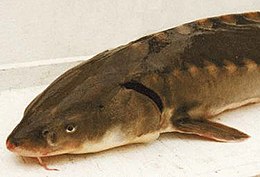Shortnose sturgeon
| Shortnose sturgeon | |
|---|---|
 |
|
 |
|
| Scientific classification | |
| Kingdom: | Animalia |
| Phylum: | Chordata |
| Class: | Actinopterygii |
| Order: | Acipenseriformes |
| Family: | Acipenseridae |
| Genus: | Acipenser |
| Species: | A. brevirostrum |
| Binomial name | |
|
Acipenser brevirostrum Lesueur, 1818 |
|
The shortnose sturgeon (Acipenser brevirostrum) is a small North American sturgeon, which can be found in 16 to 19 large river and estuary systems along the Atlantic seaboard from the Saint John River in New Brunswick, Canada, to the St. Johns River in Florida, United States. Populations may be disjunct, evidenced by lack of records in the sea outside the influence of their home river and minimal captures of tagged individuals outside the river in which they were tagged.
The species is sometimes mistaken for juvenile Atlantic sturgeon, as adults of this species are similar in size to juveniles of that species. Prior to 1973, U.S. commercial fishing records did not differentiate between the two species, both were reported as "common sturgeon", although it is believed based on sizes that the bulk of the catch was Atlantic sturgeon.
They spawn in fresh water, above the head of the tide, in moving water over rubble or gravel bottoms with little silt or organic material. Time of spawning varies by latitude and is likely based on water temperatures in the range from 9–12 °C, although successful spawning can occur from 6.5–15 °C; this may be as early as January in South Carolina or Georgia or as late as May in Maine and New Brunswick. Other spawning requirements include a day length of 13.9–14.9 hours, and water velocity at the bottom of 30–120 cm/second. The eggs hatch after 13 days, into 7– to 11-mm-long hatclings with a large yolk sac, minimal sight, minimal swimming ability, and a strong tendency to seek cover. After another 9–12 days, they mature to a swimming larval stage at about 15 mm in length, resembling a miniature adult by the time they reach 20 mm in length and begin feeding. They then drift downstream in the deep channels of the river, remaining in fresh water for the first year of their lives. Juveniles, up to 18 in long, generally move to the area where fresh and salt water come together, and move with it through the tidal cycle.
Adults can be found in either fresh or salt water. Adults mature sexually at 45 to 55 cm (18 to 22 in) in length, at an age varying with latitude. Males mature after 2–3 years in Georgia or 10–14 years in New Brunswick, and females mature between 6 and 17 years of age (again, earlier in southern rivers). First spawning occurs after sexual maturity; 1–2 years later for males and up to 5 years later for females. Adults continue to grow to between 3 and 4 ft in length. A male may breed every year or every other year, and seldom lives beyond age 30. Females usually breed every third to fifth year, laying between 40,000 and 200,000 eggs in those years in which they breed, and can live to age 67. Females spend multiple years with reduced feeding and growth while they are producing the gonadal material needed for spawning. Maximum ages are thought to be lowest in the south and highest in the north.
...
Wikipedia

